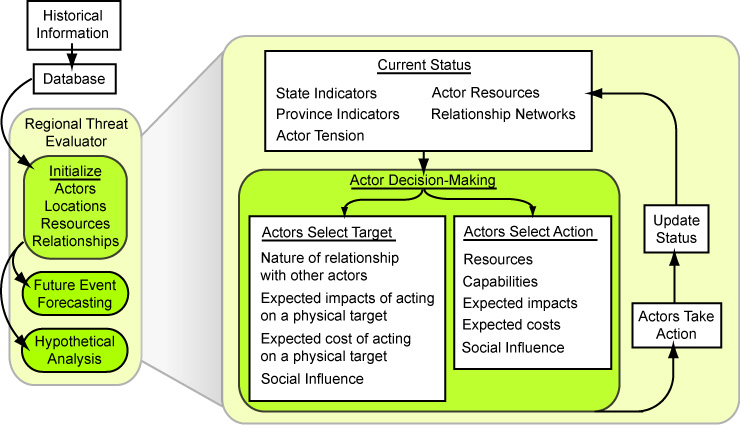RTE

"The Regional Threat Evaluator (RTE) is a multi-agent network model of state failure. In this model, boundedly-rational agents interact and take actions to achieve goals. When agents act they take into account what resources they have available, the cost and benefits of the action, and the opinions of others by whom they are influenced. These actions influence the likelihood of state failure. State failure is measured using nine factors and a composite indicator. These factors are lack of state legitimacy, potential for province secession, hostility, tension, level of corruption, level of terrorist activity, level of criminal activity, level of foreign military aid, and lack of essential services. State failure is also measured at the province level using similar indicators
.The RTE Model is based on the integration of multiple theories of social, psychological and economic behavior that collectively account for why an agent takes action and what action gets taken. It is currently being developed from a similar model based on urban threat environments. Both models were developed as special-purpose models to answer specific types of questions.
The basic idea is that inter-group conflict is due to a combination of tension and social comparison, the effects of which can be modulated by social pressure. Agents who are more tense and who see themselves at more of a disadvantage relative to others are more likely to engage in hostile actions; whereas, lower tension and higher advantage lead to non-hostile actions. Agents who have influence over the agent in question can use that influence to escalate or de-escalate the impact of tension and social comparison. Specifically, an agent who is influenced by others who themselves are tense or feel deprived will feel more tense and deprived than will an agent surrounded by others who are less tense or less deprived. Social influence derives from shared attributes such as culture, knowledge, borders, and goals and co-evolves with those attributes. It follows that the more heterogeneous a population and the more the lines of differentiation line up the greater the potential for hostility. When agents decide to take action, the action and target are selected using a bounded-rationality cost-benefit analysis subject to resource constraints. The costs and benefits of taking a particular action against a particular target are also modulated by social influence. Thus, agents are more likely to take the kinds of actions against the kinds of targets that social pressure suggests are appropriate and will be sanctioned by other agents for inappropriate action or target choice."
References:
M. A. Louie and K. M. Carley, "Balancing the Criticisms: Validating Multi-Agent Models of Social Systems," Simulation Modelling Practice and Theory, vol. 16, pp. 242 - 256, 2008.
R. L. Popp, S. H. Kaisler, D. Allen, C. Cioffi-Revilla, K. M. Carley, M. Azam, A. Russel, N. Choucri, and J. Kugler, "Assessing nation-state instability and failure," presented at Aerospace Conference, 2006.
Working paper:
M. A. Louie and K. M. Carley, "The Regional Threat Evaluator: A Dynamic-Network Multi-agent Model of Intra-State Conflict."